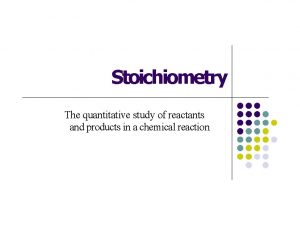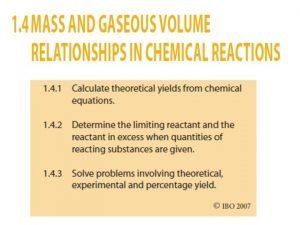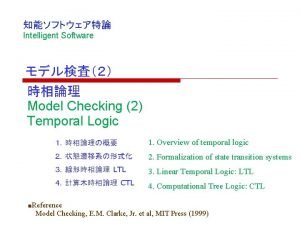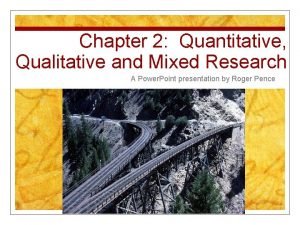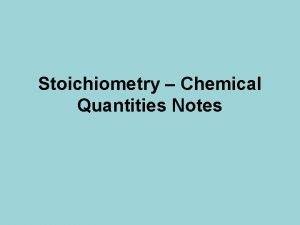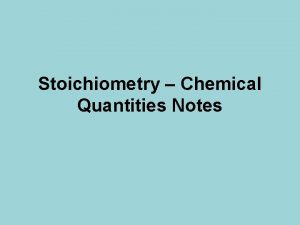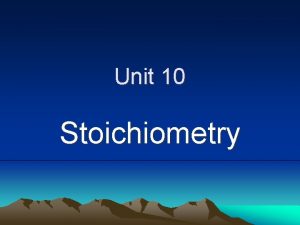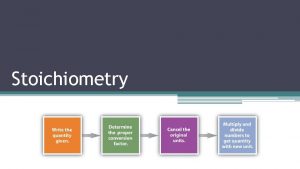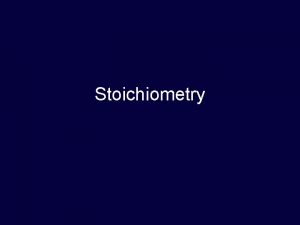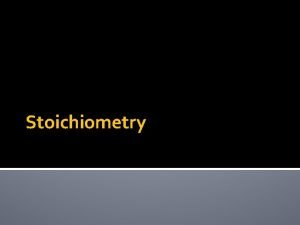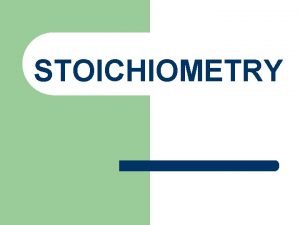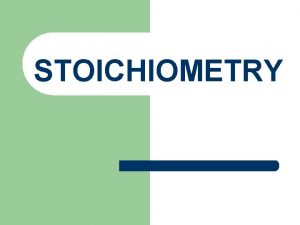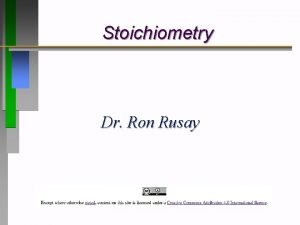STOICHIOMETRY What is stoichiometry Stoichiometry is the quantitative


















































- Slides: 50

STOICHIOMETRY!!!!

What is stoichiometry? Stoichiometry is the quantitative study of reactants and products in a chemical reaction.

Conversions we will be doing: Mole to mass, mass to mole Mass to mass Limiting Reactants % Yield

STOICHIOMETRY The Stoichiometry Flow Chart Use Molar mass (A) Use mole ratio from equation Use Molar mass (B)

Molar Volume at STP LITERS OF GAS AT STP Molar Volume (22. 4 L/mol) MASS IN GRAMS Molar Mass (g/mol) MOLES 6. 02 1023 particles/mol Molarity (mol/L) LITERS OF SOLUTION NUMBER OF PARTICLES


Mole-Mole Factor l. Shows the mole-to-mole ratio between two of the substances in a balanced equation l. Derived from the coefficients of any two substances in the equation


Writing Mole Factors 4 Fe + 3 O 2 2 Fe 2 O 3 Fe and O 2 4 mol Fe 3 mol O 2 and 3 mol O 2 4 mol Fe and 2 mol Fe 2 O 3 4 mol Fe Fe and Fe 2 O 3 4 mol Fe 2 O 3

4 Fe + 3 O 2 2 Fe 2 O 3 O 2 and Fe 2 O 3 3 mol O 2 2 mol Fe 2 O 3 and 2 mol Fe 2 O 3 3 mol O 2

Learning Check S 1 3 H 2(g) + N 2(g) 2 NH 3(g) A. A mol factor for H 2 and N 2 is 1) 3 mol N 2 2) 1 mol N 2 3) 1 mol N 2 1 mol H 2 3 mol H 2 2 mol H 2 B. A mol factor for NH 3 and H 2 is 1) 1 mol H 2 2 mol NH 3 2) 2 mol NH 3 3 mol H 2 3) 3 mol N 2 2 mol NH 3

Solution S 1 3 H 2(g) + N 2(g) 2 NH 3(g) A. A mol factor for H 2 and N 2 is 2) 1 mol N 2 3 mol H 2 B. A mol factor for NH 3 and H 2 is 2) 2 mol NH 3 3 mol H 2

Chemical Calculations 4 Fe + 3 O 2 2 Fe 2 O 3 How many moles of Fe 2 O 3 are produced when 6. 0 moles O 2 react? 6. 0 mol O 2 x mol Fe 2 O 3 = _____ mol Fe 2 O 3 mol O 2

Learning Check 2 4 Fe + 3 O 2 2 Fe 2 O 3 How many moles of Fe are needed to react with 12. 0 mol of O 2? 1) 3. 00 mol Fe 2) 9. 00 mol Fe 3) 16. 0 mol Fe

Solution S 2 4 Fe + 3 O 2 12. 0 mol O 2 x 2 Fe 2 O 3 4 3 mol Fe = 16. 0 mol Fe mol O 2

Stoichiometry Problems How many moles of KCl. O 3 must decompose in order to produce 9 moles of oxygen gas? 2 KCl. O 3 2 KCl + 3 O 2 ? mol 9 mol O 2 2 mol KCl. O 3 3 mol O 2 9 mol = 6 mol KCl. O 3

Mole to Mass (an extra step) Balance Equation Use Mole Ratios to get from Mole A to Mole B Use the Molar Mass to get from Mole B to g. B

Mole-Mass Problems Problem 1: 1. 50 mol of KCl. O 3 decomposes. How many grams of O 2 will be produced? [K = 39. 1, Cl = 35. 45, O = 16] 2 KCl. O 3 2 KCl + 3 O 2

Learning Check S 3 4 Fe + 3 O 2 2 Fe 2 O 3 How many grams of O 2 are needed to produce 0. 400 mol of Fe 2 O 3? 1) 38. 4 g O 2 2) 19. 2 g O 2 3) 1. 90 g O 2

Solution S 3 0. 400 mol Fe 2 O 3 x 3 mol O 2 x 32. 0 g O 2 2 mol Fe 2 O 3 1 mol O 2 = 19. 2 g O 2

Calculating Mass of A Substance A to Mass of Substance B n Balance equation n Convert starting amount of g A to moles A using Molar Mass n Use coefficients to write a mol-mol factor from mole A to mole B n Convert moles B of desired to grams B using Molar Mass


Calculation The reaction between H 2 and O 2 produces 13. 1 g of water. How many grams of O 2 reacted? Write the equation H 2 (g) + O 2 (g) H 2 O (g) Balance the equation 2 H 2 (g) + O 2 (g) 2 H 2 O (g)

mol bridge 2 H 2 (g) Plan + O 2 (g) ? g g H 2 O mol H 2 O 2 H 2 O (g) 13. 1 g mol O 2 Setup 13. 1 g H 2 O x 1 mol O 2 x 32. 0 g O 2 8. 0 g H 2 O 2 mol H 2 O 1 mol O 2 = 11. 6 g O 2

Example How many grams of silver will be formed from 12. 0 g copper? Cu + 2 Ag. NO 3 2 Ag + Cu(NO 3)2 12. 0 g ? g 12. 0 1 mol 2 mol 107. 87 g Cu Cu Ag g Ag = 40. 7 g 63. 55 1 mol Ag g Cu Cu Ag

Points to Remember 1. 2. 3. 4. Read an equation in moles Convert given amount to moles Use mole factor to give desired moles Convert moles to grams (given) (desired) grams moles (given) (desired) moles

Or…. We can go from moles to # of particles (atoms, molecules, formula units) by using Avogadro’s #

Learning Check S 4 How many O 2 molecules will react with 505 grams of Na to form Na 2 O? 4 Na + O 2 2 Na 2 O Complete the set up: 505 g Na x 1 mol Na x _______ 23. 0 g Na

Solution S 4 4 Na + O 2 2 Na 2 O 505 g Na x 1 mol O 2 x 6. 02 x 1023 23. 0 g Na 4 mol Na 1 mol O 2 = 3. 30 x 1024 molelcules

Learning Check S 5 Acetylene gas C 2 H 2 burns in the oxyactylene torch for welding. How many grams of C 2 H 2 are burned if the reaction produces 75. 0 g of CO 2? 2 C 2 H 2 + 5 O 2 4 CO 2 + 2 H 2 O 75. 0 g CO 2 x _______

Solution S 5 2 C 2 H 2 + 5 O 2 4 CO 2 + 2 H 2 O 75. 0 g CO 2 x 1 mol CO 2 x 2 mol C 2 H 2 x 26. 0 g C 2 H 2 44. 0 g CO 2 4 mol CO 2 = 22. 2 g C 2 H 2 1 mol C 2 H 2

Pathways for Problems Using Equations Given (A) grams (A) Find (B) grams (B) moles (A) moles (B) particles (A) particles (B)

Pathways for Problems Using Equations Given (A) grams (A) molar mass (A) Find (B) grams (B) molar mass (B) coefficients moles (A) Avogadro's Avogradro’s number particles (A) moles (B) number particles (B)

Limiting Reactants l If the amounts of two reactants are given, the reactant used up first determines the amount of product formed.

Analogy Suppose you are preparing cheese sandwiches. Each sandwich requires 2 pieces of bread and 1 slice of cheese. If you have 4 slices of cheese and 10 pieces of bread, how many cheese sandwiches can you make?

Cheese Sandwich Products Sandwich 1 + + = Sandwich 2 + + =

Learning Check S 6 How many sandwiches can you make? ____ slices of bread + ____ slices of cheese = ____ sandwiches What is left over? ________ What is the limiting reactant?

Solution S 6 How many sandwiches can you make? __10__ slices of bread + __4__ slices of cheese = __4__ sandwiches What is left over? _2 slices of bread What is the limiting reactant? cheese

Solving LR Problems 1. For each reactant amount given, calculate the moles (or grams) of a product it could produce. 2. The reactant that produces the smaller amount of product is the limiting reactant. 3. The number of moles of product produced by the limiting reactant is ALL the product that possible can possibly be made. There is no more limiting reactant left. The other reactant is called an excess reactant and some will be leftr over

Limiting Reactants Limiting Reactant � used up in a reaction � determines the amount of product Excess Reactant � added to ensure that the other reactant is completely used up � cheaper & easier to recycle

1. Si. O 2 + 4 HF → Si. F 4 + 2 H 2 O Given: 2. 0 mol HF 4. 0 mol Si. O 2 Unknown: limiting reagent

2. N 2 H 4 + 2 H 2 O 2 → N 2 + 4 H 2 O Given: 0. 750 mol N 2 H 4 0. 500 mol H 2 O 2 Unknowns: limiting reagent moles excess reactant moles of each product

3. 3 Fe + 4 H 2 O → Fe 3 O 4 + 4 H 2 Given: 36. 0 g H 20 167 g Fe Unknowns: limiting reagent mass of Fe 3 O 4 produced mass of excess reactant

4. 8 Zn + S 8 → 8 Zn. S Given: 2. 00 mol Zn 1. 00 mol S 8 Unknowns: limiting reagent moles of excess reactant moles of each product mass of each product

Percent Yield You prepared cookie dough to make 5 dozen cookies. The phone rings while a sheet of 12 cookies is baking. You talk too long and the cookies burn. You throw them out (or give them to your dog. ) The rest of the cookies are okay. How many cookies could you have made (theoretical yield)? How many cookies did you actually make to eat? (Actual yield)

Vocabulary Actual yield is the amount of product actually recovered from an experiment (will be smaller than theoretical yield) Theoretical (possible) yield is the maximum amount of product that could be produced from the reactant. Percent Yield is the actual yield compared to the maximum (theoretical yield) possible.

Percent Yield measured in lab calculated on paper

Percent Yield Calculation What is the percent yield of cookies? Percent Yield = Actual Yield (g) recovered X 100 Possible Yield (g) % cookie yield = 48 cookies x 100 = 80% yield 60 cookies

1. C 6 H 6 + Cl 2 → C 6 H 5 Cl + HCl Given: 36. 8 g C 6 H 6 excess Cl 2 actual yield of C 5 H 5 Cl = 38. 8 g Unknown: % yield of C 5 H 5 Cl

2. CO + 2 H 2 → CH 3 OH Given: - 75. 0 g CO - 68. 4 g CH 3 OH produced Unknown: % yield of CH 3 OH
 Stoichiometry is the study of
Stoichiometry is the study of Stoichiometry is defined as the quantitative study of
Stoichiometry is defined as the quantitative study of Từ ngữ thể hiện lòng nhân hậu
Từ ngữ thể hiện lòng nhân hậu Tư thế ngồi viết
Tư thế ngồi viết Ví dụ giọng cùng tên
Ví dụ giọng cùng tên Các châu lục và đại dương trên thế giới
Các châu lục và đại dương trên thế giới Thơ thất ngôn tứ tuyệt đường luật
Thơ thất ngôn tứ tuyệt đường luật Bổ thể
Bổ thể Hổ sinh sản vào mùa nào
Hổ sinh sản vào mùa nào Diễn thế sinh thái là
Diễn thế sinh thái là đại từ thay thế
đại từ thay thế Vẽ hình chiếu vuông góc của vật thể sau
Vẽ hình chiếu vuông góc của vật thể sau Hát lên người ơi
Hát lên người ơi 101012 bằng
101012 bằng Thế nào là mạng điện lắp đặt kiểu nổi
Thế nào là mạng điện lắp đặt kiểu nổi Lời thề hippocrates
Lời thề hippocrates Vẽ hình chiếu đứng bằng cạnh của vật thể
Vẽ hình chiếu đứng bằng cạnh của vật thể Công của trọng lực
Công của trọng lực Quá trình desamine hóa có thể tạo ra
Quá trình desamine hóa có thể tạo ra Tỉ lệ cơ thể trẻ em
Tỉ lệ cơ thể trẻ em Sự nuôi và dạy con của hươu
Sự nuôi và dạy con của hươu Các loại đột biến cấu trúc nhiễm sắc thể
Các loại đột biến cấu trúc nhiễm sắc thể Thế nào là sự mỏi cơ
Thế nào là sự mỏi cơ độ dài liên kết
độ dài liên kết Môn thể thao bắt đầu bằng từ đua
Môn thể thao bắt đầu bằng từ đua Hát kết hợp bộ gõ cơ thể
Hát kết hợp bộ gõ cơ thể Thiếu nhi thế giới liên hoan
Thiếu nhi thế giới liên hoan điện thế nghỉ
điện thế nghỉ Vẽ hình chiếu vuông góc của vật thể sau
Vẽ hình chiếu vuông góc của vật thể sau Trời xanh đây là của chúng ta thể thơ
Trời xanh đây là của chúng ta thể thơ Một số thể thơ truyền thống
Một số thể thơ truyền thống Gấu đi như thế nào
Gấu đi như thế nào Sơ đồ cơ thể người
Sơ đồ cơ thể người So nguyen to
So nguyen to đặc điểm cơ thể của người tối cổ
đặc điểm cơ thể của người tối cổ Các châu lục và đại dương trên thế giới
Các châu lục và đại dương trên thế giới Thế nào là hệ số cao nhất
Thế nào là hệ số cao nhất Ng-html
Ng-html ưu thế lai là gì
ưu thế lai là gì Tư thế ngồi viết
Tư thế ngồi viết Thẻ vin
Thẻ vin Cách giải mật thư tọa độ
Cách giải mật thư tọa độ Bàn tay mà dây bẩn
Bàn tay mà dây bẩn Thang điểm glasgow
Thang điểm glasgow Quantitative questionnaire
Quantitative questionnaire Quantitative reasoning 意味
Quantitative reasoning 意味 Holistic approach to research
Holistic approach to research How to develop a quantitative analysis model
How to develop a quantitative analysis model Gre quantitative comparison
Gre quantitative comparison Ap gov scotus comparison frq example
Ap gov scotus comparison frq example Independent variable in research
Independent variable in research
